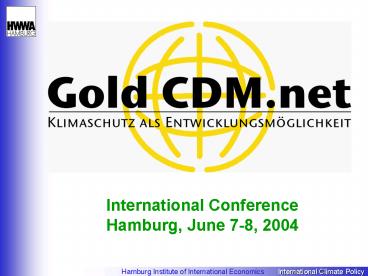Kein Folientitel PowerPoint PPT Presentation
1 / 20
Title: Kein Folientitel
1
International Conference Hamburg, June 7-8, 2004
2
- Housekeeping announcements
- Lunch
- Please mark your choice on the sheet circulating
each morning - Lunch is included (exception special drinks)
- Evaluation forms
- Please fill in forms and leave them together
with your badge in the box at the registration
desk before leaving
3
- General announcements
- Papers and presentations
- Please serve yourself with papers at our paper
table and display - Presenters will be reminded 3 minutes and 1
minute before end of allotted time - Presentations will later be available on our
website www.hwwa.de/climate.htm
4
International Conference Hamburg, June 7, 2004
The role of renewable energy in the CDM market
Axel Michaelowa Hamburg Institute of
International Economics, Germany a-michaelowa_at_hwwa
.de www.hwwa.de/climate.htm
5
Structure of presentation
- Renewable energy in the CDM pipeline
- Methodology status
- Issues surrounding additionality
- Demand for renewables CERs
- Government procurement
- The EU linking directive
- Share of CERs in total project revenue
- Share of renewables in CDM market
- Conclusion Other project types are more
attractive in the short term
6
Baseline rules Case law
- The EB does not provide a basic set of rules
beyond the Marrakech Accords text - Exception small scale projects
- All rules are developed by case law
- Project pioneers have to propose a new rule
(methodology) for each new project type - Higher validation costs
- Delay of several months
- Risk of refusal
- The CDM regime is shaped by first proposers
- Important role of validators, methodology panel
and expert reviewers
7
Stringent decisions on baseline methodologies
Passed methodologies are very project-specific
8
Submissions of baseline methodologies types
9
Submitted baseline methodologies
- Multiple methodologies for same project type?
10
Approved baseline methodologies
- Multiple methodologies for same project type!
- EB starts consolidation/standardisation
- Proposal for methodology covering all non-biomass
renewable grid-electricity generation projects - Decision at EB session June 12-14 planned
11
Additionality and renewables
10th session of CDM EB states As part of ...
determining the baseline scenario an explanation
shall be made of how, through the use of the
methodology, it can be demonstrated that a
project activity is additional and therefore not
the baseline scenario.
- Are renewable energy projects the most attractive
option? - In several host countries, renewable energy is
subsidised (India, China) - In some areas with excellent sites (Costa Rica,
Morocco) wind energy is commercially viable - Hydropower has been business-as-usual in many
countries for a long time - Biomass energy can be commercially viable if
agricultural residues (e.g. bagasse) are
available for free
12
Additionality tests - not comparable
- Flow-chart / series of questions
- Stringency depends on type of questions.
Essentially no test, but could be framework for
test - Why is the non-project option more likely?
- Should essentially be the outcome of all tests
applied, is no test in itself - Barrier assessment
- The key issue is whether barriers are prohibitive
- Project type not common practice and not required
by legislation - Only test which is objective, but does only
specify necessary, not sufficient conditions for
additionality. Still needs another test.
13
Current demand on the CDM and JI market (million
)
- Pure CDM demand about 600 million , i.e. about
150 million t at current prices of 3-5 /t CO2 - Price differentiation according to type
- Netherlands pay 5.5 for renewables, 4.4 for
bioenergy and efficiency improvement and 3.3 for
other types
14
International market differentiation
15
EU as CDM leader
- Linking directive agreed as law, April 2004
- CERs can be used in EU trading scheme from Jan.
2005 - No common CER import limit. Member state
competence and thus unlikely to be implemented - The survival of the Kyoto Mechanisms without
Kyoto entry into force is guaranteed - Sinks excluded, large hydro to follow WCD rules
- Market impact
- Private demand depends on national allocation
plans. Most published plans are weak. EU
Commission likely to refuse some of them.
Tendency to shift demand from companies to
governments - Depends on government CER / ERU import
regulations / fees
16
Impact of CER revenue on project revenues at 3
/t CO2
Source PCF 2003
17
Share of different project types in projected CER
supply
million
250
200
N2O-Adipic Acid
150
Other
Flaring
Landfill gas
100
HFC Decomposition
50
0
2000
2001
2002
2003
2004
2005
2006
2007
2008
2009
2010
2011
2012
Source Point Carbon 2004
18
Thresholds for small-scale projects and
transaction costs
19
Conclusions
- Renewables projects have been very active in
submitting baseline methodologies - Consolidated baseline methodology for renewable
electricity is likely to be approved - Many renewable energy projects have problems in
proving additionality - Existence of subsidies
- Competitiveness in good locations (hydro, wind)
- Renewable energy projects are dwarfed by other
project categories (HFC, N2O, LFG) that have less
problems with additionality and lower transaction
costs - Government procurement may favour renewables
20
Thank you!Further informationwww.hwwa.de/clim
ate.htmor climate_at_hwwa.de

